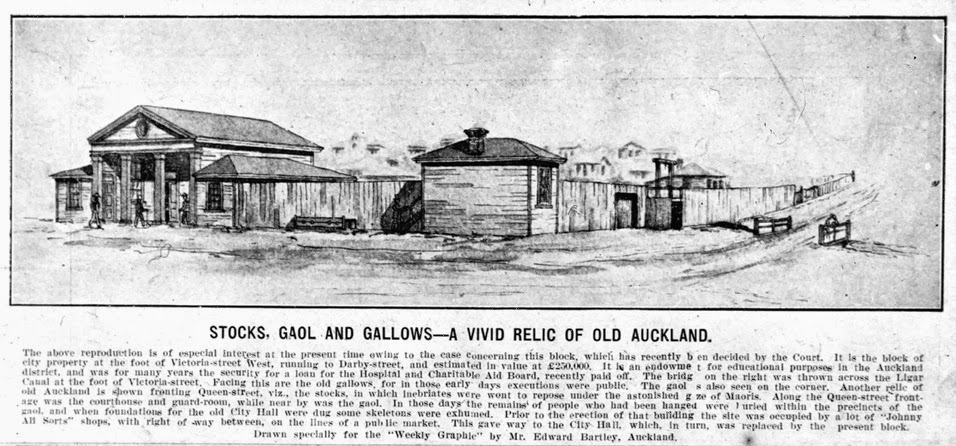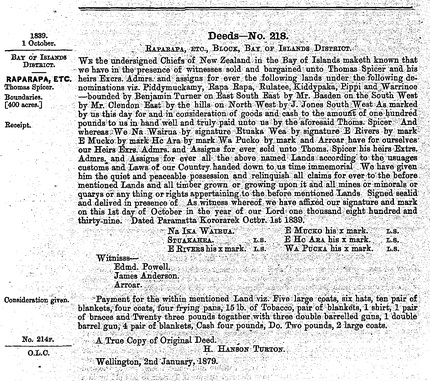Continued from September's postIntroductionBefore embarking on the next voyage to the Pacific and more horrific events surrounding the extraordinary family named Roberton, I thought I should mention a family connection to Thomas Cochrane who featured in last months blog. Jacobina Frances Nicholson a descendent of the Nicholson family of Thornton & Loanend - married as her second husband William Horatio Barnardo Cochrane, an officer in the 92nd Gordon Highlanders, the second son of Thomas Cochrane the 10th Earl of Dundonald. Researching the Roberton family can be maddening at times due to the frequent misspelling of the name as Robertson, and their propensity to move around the world. I do believe I have traced various descendents of the daughters of William Roberton of Friars & his wife Mary Gordon, with one branch in particular still living in and around Australasia. Another interesting fact that I omitted from my previous post is that despite extensive searching, the treasure hordes of Benevides at Mocha and Andrew Roberton's gold allegedly buried on Agrihan, have never been found. Allegedly Roberton even left a map but no-one can decipher it!. Other intrepid explorers are still to this day on the hunt for the "Treasure of Lima" as this article from the Telegraph in 2012 testifies:- http://www.telegraph.co.uk/news/worldnews/centralamericaandthecaribbean/ costarica/9450737/British-expedition-to-Pacific-treasure-island-where-pirates-buried-their-plunder.html I wish them more success than the German adventurer Andrew Gissler who spent 19 yrs on the Island and returned with just 6 gold coins! Another Roberton, Peter Dillon & the fate of Le Comte de LaperouseAbout the time of Andrew Gordon Roberton was embarking on his pirating career in 1822 his younger brother John had joined the Chilean Navy. As news of his brother's antics spread John realised there would be little chance of career advancement so, after achieving the rank of Lieutenant, he obtained his discharge in 1825. 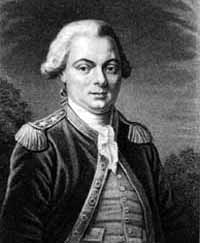 Comte de Lapérouse Comte de Lapérouse In 1826 he emabarked on a voyage with the adventurer Peter Dillon in an effort to establish the fate of Jean-Francoise Galaup, Comte de Laperouse who had been commissioned by Louis XVI of France to undertake a world-wide scientific expedition in 1783, and who had mysterioulsy vanished in 1788. Dillion was sure that if he could solve this mystery he would be handsomely rewarded by the French if he could succeed. Succeed he did - establishing the fate of Laperouse's two ships 'Boussole' & 'Astrolad' in a freak storm off the island of Vanikoro in 1788. One ship had broken up on rocks almost immediately, the other had come to rest on the reef and many had survived (but that is another story). Dillon bartered and brought back artefacts & relics from the wrecks to prove his discovery that included Laperouse's silver sword guard. Having made haste to Calcutta and reporting his finds to Govenor General he was commissioned by the Honorable East India Company to continue his search. In 1827 John Roberton again set sail with Dillon. More evidence was found but the ship was forced to return the Bay of Islands and subsequently Sydney due to sickness amongst the crew. It is here that Dillon & Roberton parted company. In 1829 Dillon went to France to collect his reward. He was presented to the King, given the title 'Chevalier of the Legion of Honour' and granted an annuity of 4000 francs for life. However, as with many of these tales it does not end well! After a further stint in the Pacific Peter Dillon died in Paris in 1847 "poor and prematurely aged". Any reward paid to John remains a mystery. 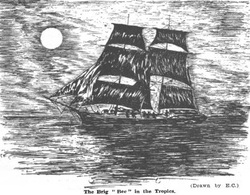 The Bee The Bee In October 1834 John Roberton married Elizabeth Holmes and made his first voyage as Captain of 'The Bee'. This little brig had enjoyed a rather chequered career under her previous owner ex convict William Cuthbert. "Lincoln Bill" a trader who was later arrested for dubious dealing, theft and unpaid debts. In 1836 John had exchanged 'The Bee' for 'The Caroline' and continued to trade with the native New Zealanders. In 1837 he purchased 40 acres at Waihihi near Kororareka (present day Russell) overlooking the Bay of Islands. He spent a further £150 building a house which he named Kelso after his birthplace. By the time of his death in 1841 his land holding in Waihihi & Maiki extended to approximately 150 acres. Kororareka at the time was a well known whaling port and was developing a bit of a reputation and I have found it described thus:- "Traders established themselves here, and a rowdy population of runaway sailors, ex-convicts, bad characters, and debauched Maoris filled the place. Drunkenness and riot were the general order of things; and it was even said that Kororareka was developing into a nest of pirates. There was no sort of government to restrain the evil, and man's passions were transforming a natural Eden into a hell" Dodgy Dealings with a bishop...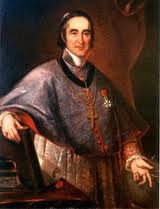 November of 1838 saw the arrival of the Catholic Bishop Jean Baptiste Francois Pompallier intent on establishing a Mission in the Bay of Islands. In an attempt to prevent this from happening the Anglican faction set about buying up every bit of land that became available. Not our Roberton - he apparently made a 'gift' to the Bishop of 4.5 acres of his land for which he received 1 shilling per acre. There was a catch however (well there would be in an area that at the time rivals the Borders when 'reiving' was at its height). John purchased the mission ship 'Reine de Paix' (Queen of Peace!) from the Bishop for a sum of £600. He paid half & mortgaged the balance against his property at Waihihi. Being a relatively young man of 35 this would appear to be a relatively low risk investment for both parties, despite the questionable sea worthiness of the ship. Bishop Pompallier continued to buy other adjoining plots of land using the balance of John Roberton's mortgage as security. As the following events unfolded, not only would they leave a lasting impression on the history of New Zealand - I am sure it left his family wishing he had life assurance! Motuarohia or Roberton Island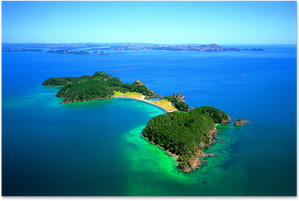 Roberton Island Roberton Island In September 1839 John paid over £213 and bought Motuarohia which he renamed Roberton Island, from three local Maori chiefs including the influential chief Rewa, with whom he and his close friend & colleague Captain William Brind had many previous dealings. A large house was built at a cost of £650, a not inconsiderable sum and a far departure from the two roomed houses favoured by settlers in those days. To all accounts an idyllic location in which to raise a family. John moved his wife and son Gordon to the island and a daughter was born in 1840. A quotation from the papers of Maurice Lennard who had accidentally come into possession of papers relating to the Island & the Roberton family describes the house thus in 1959:- "a wood frame structure roofed with split shingles, situated on a small flat between the beach and the hills to the westward of the two lagoons in the south-eastern bay. The foundations were boulders......these foundation stones were visible just a few years ago" Disaster strikes...Settled and the farming enterprise begun using labour from Kororareka, disaster struck the following September. Whilst sailing for his own pleasure in a new boat Roberton was drowned. In a letter home to John's parents Elizabeth writes:- "He was unfortunately opposite our house and island. He was sailing merely for his own amusement in a new boat that had just come from the builder. It was very large, only one small boy with him in the boat, they were caught by a sudden gust of wind and in one moment they disappeared and drowned. I have had three boats employed for this last fortnight searching for their bodies but with little success. A few days ago a small part of my poor Roberton's breast with fishes teeth marks in it were found....." In his Will John had left everything to his wife, but problems with probate prevented Elizabeth from selling up and returning home. She continued to farm the land and by the time probate was finally granted on 11 November 1841, things appeared to have achieved a degree of normality. Thomas Bull was employed as farm manager and was assisted by a 16 year old Maori boy named Maketu. At this point the house was occupied by Elizabeth, 8 year old Gordon, his 2 year old baby sister, Askina, and by Isabella Brind also 2yrs old. Isabella was the daughter of Captain William Brind and Moeweka, daughter of Chief Rewa (from whom the Island had originally been purchased) & with whom he had a lengthy liaison. 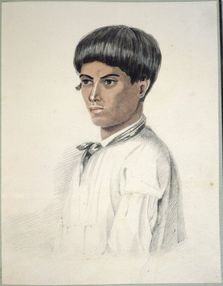 Maketu Maketu The relationship between Thomas Bull and Maketu were strained and tempers flared. As the son of a Maori Chief, Maketu saw himself as an aristocrat and resented taking orders from Bull - a mere servant. Aside from this Maketu and his family reportedly had a history of violent behaviour. His brother and sister were apparently deranged, his aunt had strangled herself in a fit of rage and his father had "fits of frenzy". According to Maori custom, in order to preserve his position in Maori society, Bulls insults and abuse demanded revenge. On the night of Saturday the 20th November 1841 Maketu waited until Thomas Bull was asleep and killed him with an axe. He went to report the incident to Mrs Roberton in the belief that she understood Maori customs and would accept it as such. This was not the case! Since the signing of the Treaty of Waitangi, New Zealand, whilst respecting the land ownership of the Maori people, was firmly under British rule. Realising his mistake, that the country had new laws and he would surely hang for his crime Maketu butchered Elizabeth and the two baby girls. He then set fire to the house. In the meantime Gordon had fled, Maketu pursued him across the island to the top of Pa Hill where he threw the 8yr old boy of the cliff to be killed on the rocks below. The large column of smoke alerted residents on the mainland who set out to investigate, discovering the three corpses in the still smouldering house, and the following day that of Thomas Bull under a blanket. Initially the incident was blamed on Maori tribal warfare and fear spread throughout the community. The following Tuesday, Lieut Ellerman of the ship 'Favourite' finding no evidence of a Maori war party concluded that the incident was an individual case of murder. Maketu was eventually arrested on the 24th November and admitted that he had committed all five murders at the subsequent inquest. How the matter should be dealt with caused a deal of intertribal unrest, with some believing the matter would be best dealt with by his own people. The turning point in the proceedings came when Chief Rewa supported the movement for it to be dealt with "in house" as revenge for the murder of Isabella Brind his granddaughter and one of Maketu's victims. Despite Rewa's intervention Maketu was tried by the Supreme Court in Auckland on the 1st March 1842 and publicly hanged a week later. 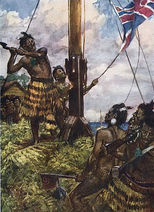 Maketu was the first person to be hanged by the British legal process in New Zealand. It was the manner in which the sentence was carried out rather than the sentence itself which inflamed an already delicate situation. Chief Rewa was insensed at this further strike out against the customs of the native tribes. The delay in carrying out sentence was considered an insult but the final blow was that the public hanging of Maketu failed to respect his chiefly status within Maori society. Rewa's need for revenge for the murder of his granddaughter was compounded by these events and whilst not the only cause for the subsequent attack on Kororareka known as the "Flagstaff Wars" three years later, it was considered a significant contributory factor. The Battle for the LandThere now follows a most bizarre sequence of events. Mary, John's mother had been widowed in 1840, her husband William being buried on Boxing Day 1840 at New Calton cemetery Edinburgh. "Late of Friars, residing at No 1 Scotland Street". His will does not appear in the Edinburgh Sheriffs Court books until August 1846, where he is described as "late tenant of Friars now residing at High John Street, Glasgow". In 1843 Mary aged approximately 70 departed on the 'Gannet' for Australia leaving her only yet unmarried daughter Violet behind, possibly with her married sister Sophia Horetzky who in 1841 was also living in Scotland Street. 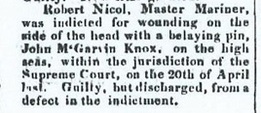 Following an arduous journey with a bully for a Captain Mary finally arrived in Melbourne where Captain John Nichol was charged with assault on both Mary and a fellow passenger John McGarvin Knox. Captain Nichol was discharged due to a technicality and his brother Donald took command of the Gannet and they continued their journey. Mary in the company of Dr John Wright arrived unscheduled in Hobart, Tasmania on 4th July 1843 and from there on to Wellington. (Dr Wright was financing her trip in exchange for all John's property with Mary only retaining a half interest for life. Even more bizarre was a written agreement to this proposal from her daughters - thus disinheriting themselves. The document referred to above, amongst others forms part of the collection of Maurice Lennard). Mary finally arrived in Auckland on the 7th November 1843, having wasted the interim period and a good deal of money in Wellington sueing Captain Nichol of the 'Gannet' for abuse and unnecessary delays resulting from the unscheduled stop. On arrival she found John's Waihihi property in ruins and uninhabitable and the house on the Island had been burned down. A man named William Wilson had taken it upon himself to run John's estate and after selling his stock and taking the rents had vanished. All Mary could recover was a gold watch a few pieces of jewellery and other small items that had been held by the Court for safekeeping. A series of unpleasant legal wranglings ensued - Wright took possession of Roberton Island and accused her of attempting to defraud him. Bishop Pompallier had conveniently forgotten the gift of 4.5 acres and was holding the Deeds to the entire Waihihi property, not just the 40 acres that was security against the original mortgage. This was finally resolved by a ruling in Mary's favour in 1845. By this time the Flagstaff War had broken out and Mary retired to Auckland where she died aged 77 in 1850.  The land disputes continued and included the fraudulent claim by Mr B E Turner an associate of Dr Wright. Mr Turner claimed the Island had been transferred to him by Dr Wright to settle unpaid debts. He further claimed the transfer document had been burned in his home during the attack on Kororareka. This was proved to untrue from the papers of Maurice Lennard over 100 years later. However Mr Turner was in occupation of the Island for over 30 years. The final attempt by the Robertons (John's married sisters) was made in 1865 and came to nothing owing to the death of their solicitor in England. The claim was declared abandoned in 1880. Notes on the Family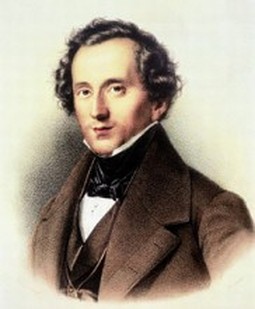 Felix Horetzky Felix Horetzky The married sisters referred to above I believe to be:-
The most interesting and numerous descendents hail from the marriage in 1821 at Friars, Kelso of Elizabeth, (died circa 1835) another sibling, to James Stanislaus Bell. (His brother was John Zephaniah Bell (1794-1883) the Scottish artist). Their daughter Jane migrated to Australia with her husband William Bogle. The remaining children from this match that survived until adulthood went to New Zealand. The Christian name Randall makes an interesting reappearance too. (Anne 'Randall' Scott Grant being the wife of Alexander Ballantyne). To conclude....Whatever these Robertons were, they can never be accused of being boring non achievers. This family from Kelso has left a lasting impression in a fascinating chapter in the history of New Zealand's early settlers. In researching these last two posts I have come across a couple of conflicting references.
Should any Roberton descendants happen upon this blog would they pay heed to the suggestion that in the interests of self preservation, their occupations and hobbies be strictly land based! An interesting link.
A graphic first hand account of the Coroners inquest in Nov 1841. http://trove.nla.gov.au/ndp/del/article/8752365?searchTerm=brind&searchLimits=sortby=dateAsc|||l-decade=184|||l-category=Article Mrs Roberton as an author. http://www.british-fiction.cf.ac.uk/titleDetails.asp?title=1826A068 New Zealand Land records University of Wellington http://nzetc.victoria.ac.nz/tm/scholarly/tei-TurOldP-t1-g1-g1-g2-g87-t1.html
12 Comments
25/10/2013 08:18:53 am
Fascinating October Blog re the Kelso New Zealand connection. I have posted a photo on facebook of Chatto Creek in New Zealand. Chatto is high in the hills above Kelso. In Lynwood Cemetery in Christchurch I found and Old Babington Colonel grave who had married a Kiwi and also in Aukland where my Grandfather from Kelso lived, Hobson Street. Such an interesting blog. Maggie xox
Reply
Susie
25/10/2013 01:35:57 pm
Many thanks for your compliments. Pleased you enjoyed my October blog. For my piece on Lennel Hill you will need will to look at July's archive. Those of us with 'border blood' did (and continue to do) extraordinary things!
Reply
Ann Humble
25/10/2013 08:42:19 am
More savage tales than the Reivers in the Borders !
Reply
Susie
25/10/2013 01:38:35 pm
I take some small comfort in the fact that the Reivers didn't actually EAT their victims!
Reply
Susie
25/10/2013 01:40:01 pm
I've a couple of things up my sleeve ;-)
Reply
3/10/2014 11:20:46 pm
A terrific account of the exploits of the Roxburgh Robertons. John Cresswell whom you mention is a relative by marriage. If you care to make contact I have a photograph of the location of the gallows where Makers was hanged.
Reply
9/12/2014 05:25:04 pm
Hello Susie. My name is Patricia Colmore-Williams and I am a published Bay of Islands historian. Your take on the Maketu murders of the Roberton family, John Bull and Eliza Isabella Brind is very interesting from a Bay of Islands point of view. Well done! One question though - Elizabeth Roberton's maiden name was Holmes? I would be interested to know if you have a marriage certificate in support? I understand from the Brind family that Elizabeth Roberton was Elizabeth Campbell. She was the sister of Ann Campbell who married Walter Brind, Capt William Darby Brind's brother. Elizabeth Roberton was connected to Capt William Darby Brind, the father of the half-caste child Eliza Isabella Brind in 2 ways; 1. Her husband John Roberton and Capt. William DarbyBrind were close friends 2. Roberton's wife Elizabeth (nee Campbell) was a sister to Ann Brind (nee Campbell, the wife of Brind's brother Walter Brind. This is how Elizabeth Roberton came to be looking after Brind's half-caste child. As a matter of interest Walter and Ann Brind first came to New Zealand on the 'Bee' in c1835-6. The ship was presumably captained by John Roberton.
Reply
Leszek Cesarczyk
11/11/2017 03:07:48 am
Dear Susie,
Reply
Susie Douglas
11/11/2017 06:08:53 pm
Hi there Leszek
Reply
Scott Graham (Joseph Roberton) Cheyney
7/12/2017 10:39:41 pm
Dear Susie
Reply
Monica Horsburgh
23/9/2022 01:35:14 pm
Hi Susie,
Reply
Leave a Reply. |
AuthorSusie Douglas Archives
August 2022
Categories |
Copyright © 2013 Borders Ancestry
Borders Ancestry is registered with the Information Commissioner's Office No ZA226102 https://ico.org.uk. Read our Privacy Policy
